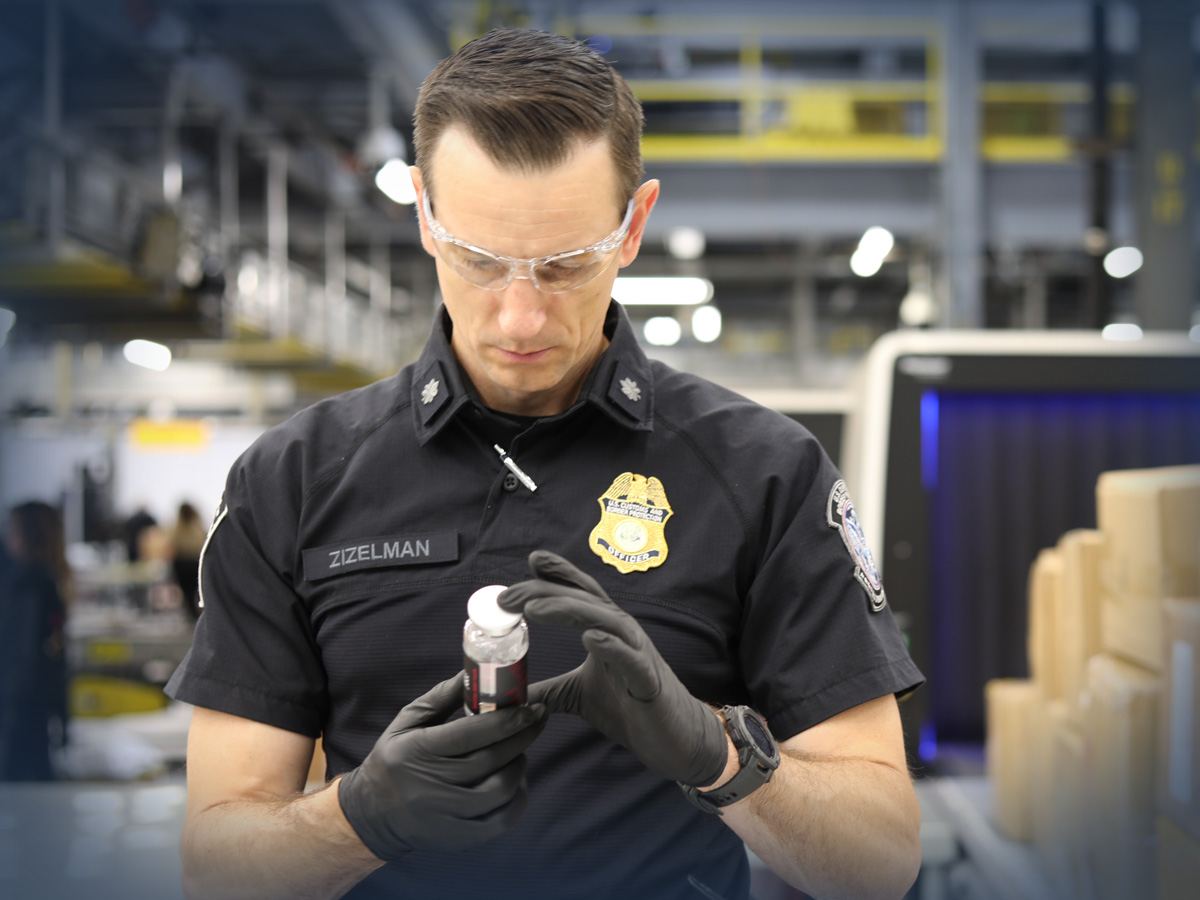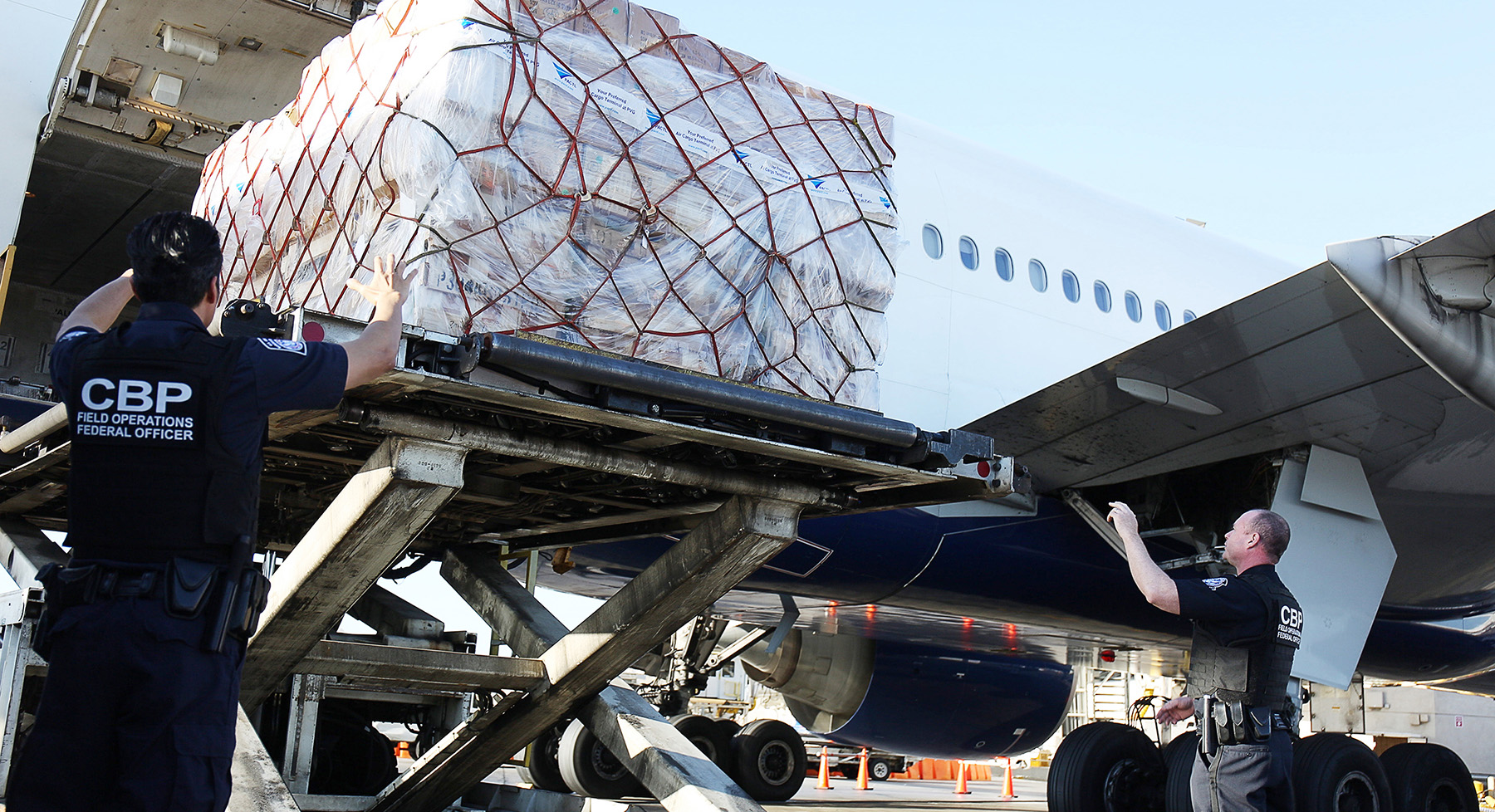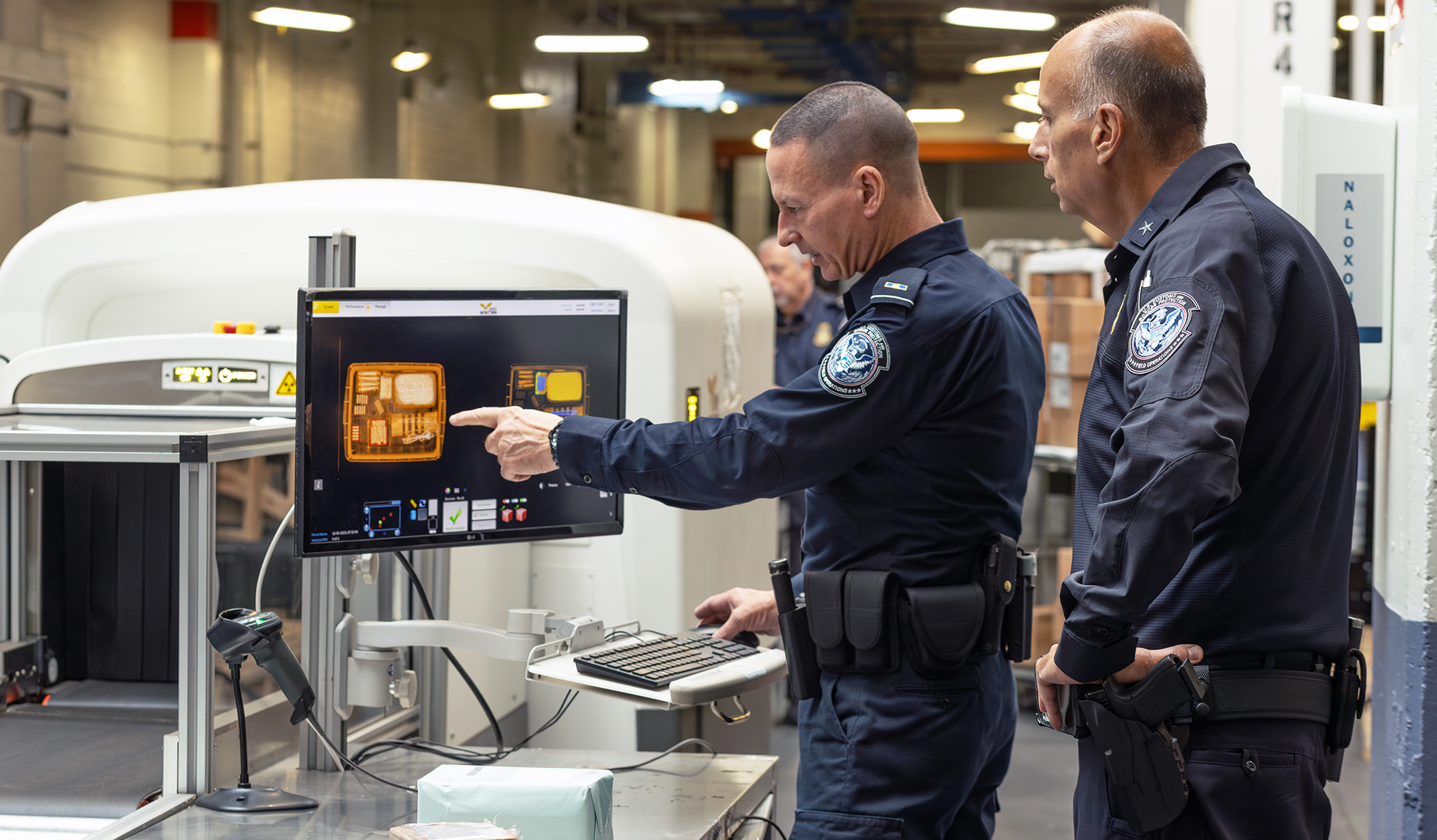
Buyer Beware: Bad Actors Exploit De Minimis Shipments
Propelled by online shopping, the number of duty-free de minimis shipments arriving at U.S. ports is skyrocketing. Bad actors are exploiting the explosion in volume and putting consumers at risk. Above, Chief Supervisory CBP Officer Eric Zizelman examines the contents of an express cargo shipment at the Port of Cincinnati. Photo by Sharon Bishop
Contrary to popular belief, good things do not always come in small packages. In fiscal year 2023, 85% of the shipments U.S. Customs and Border Protection seized for health and safety violations were small packages. The packages contained dangerous materials that could cause serious harm to American consumers and the U.S. economy. Propelled by online shopping, duty-free de minimis shipments—packages with an aggregate value of $800 or less—are skyrocketing and putting consumers at risk.
Currently, de minimis shipments account for 92% of all cargo entering the U.S. and that figure is growing in epic proportions. CBP processes approximately 4 million de minimis shipments a day, up from 2.8 million last year. Bad actors are exploiting this explosion in volume to traffic counterfeits, dangerous narcotics, and other illicit goods including precursor chemicals and materials such as pill presses and die molds used to manufacture fentanyl and other synthetic drugs that are killing Americans.
The majority of the more than 1 billion de minimis shipments CBP processed last year were in the air environment. Roughly 800 million, or 88%, of these shipments arrived through international mail; express courier services such as UPS, DHL, and FedEx; or were transported as cargo on commercial airline flights. At John F. Kennedy International Airport in New York where 25% of all de minimis shipments are processed, the volume is staggering. “On any given day, we could receive and process 750,000 to a million de minimis shipments,” said Andrew Renna, Assistant Port Director for Cargo Operations at JFK Airport. Along with four express courier facilities, the airport houses the country’s largest by volume international mail facility where 60% of international mail arrives in the U.S. “We have limited resources,” said Renna. “We only have X number of staff. There is no physical way if I doubled or even tripled my staffing that I could look at a significant percentage of that. So due to the volume, it’s a very exploitable mode of entry into the U.S.”

De minimis shipments account for 92% of all cargo entering the U.S. Above, CBP officers are offloading de minimis shipments from a plane at Los Angeles International Airport. Photo by Ya-Huei Laura Lee
“De minimis,” a Latin expression that means trivial or so minor that something can be disregarded, is anything but in the trade realm. Bad actors employ a number of techniques to smuggle items or evade paying duties. Undervaluation of goods, misclassification of merchandise, inaccurate or vague cargo descriptions, and describing products as something innocuous when, in fact, they’re harmful are just a few of the tactics.
“We’ve encountered shipments that have been declared as footwear and jackets, but found smuggled beef, pork, and poultry animal products instead,” said Renna. “The products are prohibited in the United States because of the risk of foreign animal disease. Should an animal disease outbreak occur in the United States, it could have significant impact on the U.S. economy and the world economy. Any disruption to the food supply chain causes economic harm,” said Renna. “Just this year so far at JFK, we have seized over 33,000 pounds of prohibited animal products in the de minimis environment. Many of the countries that we’ve seized this from are affected by African swine fever, foot-and-mouth disease, and avian influenza or bird flu. The beef, pork, and poultry industries are collectively worth over $200 billion annually in the U.S. and they support millions of jobs. So in just this one area, where de minimis is being exploited, it’s harmful to our domestic agriculture supply.”
Narcotics pathway
De minimis shipments are also a major pathway for illicit drugs. “The drug trafficking organizations use de minimis to import precursor chemicals, pill presses, and pill dies to manufacture counterfeit pharmaceuticals that would lead someone to believe that, ‘Oh, that’s just oxycodone,’ when, in fact, the pills were produced illicitly and laced with deadly amounts of fentanyl, xylazine, and nitazene compounds,” explained Renna. “Xyalzine is a farm animal sedative with legitimate veterinary use, but there is no legitimate medical use for nitazenes. Nitazene compounds are synthetic opioids that can be up to 40 times stronger than fentanyl and up to 800 times more potent than morphine, depending on the compound. Earlier this month, we seized almost a pound of nitazene that was going to a private residence in South Carolina. It was shipped from the United Kingdom,” he said. “Unfortunately, here at JFK, we’re seeing xylazine and nitazenes at least a few times a week in quantities ranging from just a few grams to upwards of a pound or more,” said Renna, who underscored the seriousness of the problem, adding, “Based on data from the Centers for Disease Control and Prevention, there were 107,543 overdose deaths in 2023, which equates to one overdose death every 5 minutes in America. It’s totally unacceptable and it must stop.”
Guns and weapon parts are also prevalent in de minimis shipments. The methods of concealment can be highly creative. For example, in March 2022, a de minimis package containing an MRE, ready-to eat survival meal, arrived at the JFK International Mail Facility from Russia. The shipment, which was purchased online by an individual in Montana, had been flagged by CBP’s National Targeting Center for potentially containing gun parts. “When we initially inspected the package, we didn’t find any gun parts. It looked like a perfectly normal, perfectly sealed survival meal with dried food, juice, and a block of chocolate,” said CBP Officer Bladimir Cisneros, who works at the JFK International Mail Facility.
The MRE was about to be sent to CBP’s agriculture specialists for further inspection when Cisneros decided to take a second look at the parcel. “I thought, ‘Something is off here,’ and I took the parcel back to our inspection table and used a utensil to poke at the chocolate.” Underneath the coating of chocolate, Cisneros saw something shiny. He realized it was a piece of aluminum foil with something wrapped inside. Cisneros ran the block of chocolate through the X-ray machine again and this time found a receiver for an AK-47 assault rifle. “It was completely covered in chocolate,” said Cisneros.
The AK-47 receiver was seized and CBP targeted the shipper, which led to seven additional seizures of parcels with illegal weapon parts. Then, the shipments stopped. “They knew we were on to them,” said Cisneros. “But six months ago, the parcels with weapon parts started arriving again. We seized those shipments and now they have stopped completely.”
The JFK officers also routinely seize auto sears, an illegal gun part that converts semi-automatic firearms into fully functioning automatic machine guns, and silencers, which can be affixed to semi-automatic weapons to silence gun shots. These weapon parts are also smuggled in innovative ways. For example, when Cisneros examined another de minimis parcel from Russia, he found it suspicious. The package was manifested as a grease gun, a garage tool used to lubricate auto parts. Cisneros noticed that the air bill was three times higher than the cost of the tool, which was $25. “I thought, ‘Why would somebody pay that much to import a tool from Russia when it would only cost $10 to $15 at a local hardware store?’ It just didn’t add up,” he said. But when Cisneros X-rayed the grease gun, he couldn’t find anything out of the ordinary. It wasn’t until he disassembled the tool that he found several auto sear gun parts cleverly concealed inside.
Suspicious shipment
De minimis health and beauty product shipments can raise red flags too. In February, while CBP officers at the Port of Cincinnati were conducting inspections on freight from Colombia, they discovered a shipment of pre-filled injection pens manifested as Ozempic. They also noticed that the writing on the package was all in Spanish. “It looked suspicious,” said Eric Zizelman, the Chief Supervisory CBP Officer at the Port of Cincinnati, one of the country’s major express courier hubs. “The way it was packaged and the way it was shipped was not the way a legitimate Ozempic package would be shipped. We consulted the FDA and found out it wasn’t approved and we seized the package.”
But that wasn’t the end of it. Ten more Ozempic shipments from Colombia, just like the first one, were seized at the port over the next few months. The shipments were headed to New York, Massachusetts, and Texas, but not to doctors’ offices, pharmacies, or medical facilities. The shipments were going to individuals who had purchased the product online. That could be dangerous, warned Zizelman. “If you’re not purchasing FDA-approved products through established distributors that are officially approved to distribute medications, you can’t trust that you are getting the legitimate product that is safe to consume. There is a real possibility this product could be harmful because we don’t know how the product was produced, if the manufacturing facility was sterile, or if the product contains what it says it contains. Something harmful could have been added,” said Zizelman. “We see a lot of unregulated merchandise that’s not approved by the FDA coming into our port. We want to make sure the public is safe. Our job is to protect the American public. We take pride in what we do.”
“There are other aspects the general public might not think about,” continued Zizelman. “In a lot of instances, we’ve been discovering that items are coming in made with forced labor, particularly out of the Uyghur Province in China. We’ve also seen countless shipments of counterfeit goods, mostly clothing and consumer products. It’s been proven that the proceeds from counterfeit goods support organized crime and terrorism. Furthermore, people probably don’t realize that when they buy counterfeit goods, they are undercutting American businesses, which is driving prices up for consumers. So, it’s important to think twice before buying de minimis shipments online.”
Operation Blind Spot
Last September, CBP ran a one-week special operation called Operation Blind Spot. “We were targeting prohibited contact lenses that are being imported as de minimis shipments into the United States from South Korea, where most of the cosmetic and beauty products are manufactured. Several ports of entry participated. LAX was one of them,” said Thomas Reis, CBP’s Section Chief for Trade Enforcement at Los Angeles International Airport.
“We conducted 41 examinations at the international mail facility and 50 examinations at the express courier hub. Out of the 91 targeted exams, 100% did not meet FDA regulatory requirements. In other words, none of the contact lenses met American safety standards to bring goods into the U.S.,” said Reis. “With a contact lens that isn’t FDA approved, it could cause eye irritation or even potential blindness. A lot of consumers might purchase these products because they’re cheaper and a good deal, but the old saying, ‘it’s too good to be true,’ is often true in the de minimis environment.”
While the lion’s share of low value shipments are transported by air, de minimis shipments enter the U.S. through all modes of transportation—including truck, rail, and sea. “We are seeing de minimis products coming in every way that someone could bring something into the United States,” said Supervisory CBP Officer James Moore who works in CBP’s Cargo, Conveyance, and Security Division. “It’s very challenging for CBP. We’ve never seen the kind of volume or smuggling that we’re currently seeing with de minimis shipments. Importers go to great lengths to smuggle items in.”
For example, in April 2023, CBP’s Trade Enforcement Team at the Port Everglades seaport in Fort Lauderdale, Florida, discovered a disassembled helicopter that arrived in 21 crates inside a 40-foot sea container from Venezuela. The helicopter was shipped as de minimis and manifested with the vague misclassified description, ‘personal effects.’ “The importer was trying to smuggle in a helicopter,” said Moore, “However, a disassembled helicopter like this one does not qualify for de minimis. Most aircraft components exceed the $800 de minimis threshold.”

CBP Officer Ronald Moy, left, and CBP Section Chief for Trade Enforcement at Los Angeles International Airport Thomas Reis inspect an intercepted de minimis parcel from Bangkok, Thailand. The shipment was manifested as “fish and seaweed snacks,” but upon examination the officers discovered smuggled Botox vials, syringes, and medical devices. Photo by Fiel Danvin Denina
Master carton smuggling
Master carton shipping is another smuggling trend. “Individually wrapped boxes are shipped inside a bigger box or a master carton. The importer is trying to hide who is actually getting the package and the contents inside,” explained Moore. “Often there is fake postage and labels on the smaller boxes. When the post office scans the labels, it will still read the address and deliver the package without payment, creating a huge loss of revenue for the U.S. Postal Service.”
“The master cartons are shipped from China while the smaller packages with the fake addresses appear to be mailed within the U.S., so American consumers aren’t aware that they are making an international purchase and may not be as worried about the product because they think it’s coming from the United States,” said Moore.
A significant example of master carton shipping occurred in March 2023. The shipment, which was manifested as a “mobile phone shell,” originated in China and transited through South Korea and Canada before heading to Denver, Colorado, its ultimate destination. But CBP intercepted the shipment for a random exam in San Francisco, where the agency’s area field office is located. Inside the master carton, the examining officers found 14 pre-labeled packages ready to be sent to a fulfillment warehouse in Plain City, Ohio. Each package contained 2.2 pounds of a white, crystalline material in a sealed bag. The officers tested the substance and positively identified it as N,N-dimethylpentylone or dipentylone, a synthetic cathinone stimulant on the DEA’s Schedule 1 controlled substance list.
The San Francisco CBP officers seized the package and alerted the other ports. A month later, another master carton containing the narcotic N,N-dimethylpentylone hydrochloride was intercepted at LAX. “This was one of 17 shipments we seized; all were transshipped from China through South Korea,” said Reis. The master carton smuggling led to a raid at the warehouse in Plain City, Ohio, where federal investigators seized more than 1,760 pounds of narcotics. “These are dangerous, deadly drugs and we’re working hard to keep them off the streets,” said Reis.
CBP is currently developing tools to tackle the challenges of de minimis shipments. Artificial intelligence, algorithms, machine learning tools, and new technology are key elements of how the agency is working to address the issues de minimis packages have ignited. Case in point is a nonintrusive detection tool that was introduced at the JFK International Mail Facility in 2021, and now is being used at other ports around the country. The detection tool was the winning entry of a contest jointly sponsored in 2019 by CBP, the Department of Homeland Security’s Science and Technology Directorate, the Office of National Drug Control Policy, and the U.S. Postal Inspection Service. “Private innovators were asked to come up with ideas to rapidly detect illicit opioids in de minimis packages in a nonintrusive way,” explained Renna. “This device enables us to develop artificial intelligence machine learning to program into the screening equipment that will identify not only illicit opioids, but other illegal substances or contraband that we encounter in the de minimis environment.”
Since 2019, CBP has been running two test/pilot programs to address the escalating threats found in low-value packages. The programs allow CBP to collect additional data to identify the parties responsible for de minimis shipments, the contents of packages, and their final destinations—all of which helps CBP clear legitimate shipments faster while focusing the agency’s resources on possible bad actors. CBP also has taken actions to address noncompliance. This includes broker compliance visits and broker suspensions for continued noncompliance with de minimis shipment requirements. Additionally, the Biden-Harris Administration announced in September that it will be taking new actions to protect American consumers, workers, and businesses from the increased abuse of de minimis exemptions and to strengthen efforts to target and block shipments that violate U.S. laws.
As a long-term solution, CBP drafted legislative proposals as well as regulations. “The proposals seek to modernize the laws,” said Renna. “There have not been any significant changes to the regulatory requirements since 1995, and the trade landscape has changed dramatically over the last 30 years. The framework that’s in place no longer works for the current environment.” The legislative proposals and the regulatory drafts include much needed reforms, including the creation of a new process for entering low-value shipments into the U.S. “This will enable us to have the tools we need to do our jobs more effectively to keep Americans safe,” said Renna. “But consumers need be cautious,” he warned. “Don’t be fooled by cheap prices. It might cost you more in the long run.”

CBP Officer Steven Nethersole, left, shows Assistant Port Director for Cargo Operations at JFK International Airport Andrew Renna suspicious merchandise in a de minimis package using a nonintrusive detection tool at the JFK international mail facility. The device, which uses artificial intelligence and machine learning, is one of the tools CBP is using to screen shipments for illicit opioids and other contraband. Photo by Michael Nicholas








